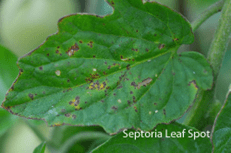Two common leaf-spot diseases will likely appear on tomatoes once the weather starts to heat up. Septoria leaf spot and early blight are both characterized by brown spots on the leaves.


Septoria leaf spot usually appears earlier in the season than early blight and produces small dark spots. Spots made by early blight are much larger and often have a distorted “target” pattern of concentric circles. Heavily infected leaves eventually turn yellow and drop. Older leaves are more susceptible than younger ones, so these diseases often start at the bottom of the plant and work up. Mulching, caging, or staking keeps plants off the ground, making them less vulnerable. Better air circulation allows foliage to dry quicker than in plants allowed to sprawl.
Mulching also helps prevent water from splashing and carrying disease spores to the plant. In situations where these diseases have been a problem in the past, rotation is a good strategy. Actually, rotation is a good idea even if you have not had problems in the past. But many gardens are too small to make it practical. If you have room, rotate the location of the tomatoes each year to an area that has not had tomatoes or related crops (peppers, potatoes, eggplant) for several years.
If rotation is not feasible, fungicides are often helpful. Be sure to cover both upper and lower leaf surfaces, and reapply fungicide if rainfall removes it. Plants usually become susceptible when the tomato fruit is about the size of a walnut. Chlorothalonil is a good choice for fruiting plants because it has a 0-day waiting period, meaning that fruit can be harvested once the spray is dry.
Chlorothalonil can be found in numerous products including Fertilome Broad-Spectrum Landscape and Garden Fungicide, Ortho Garden Disease Control, GardenTech Daconil, Bonide Fungonil and others. Be sure to start protecting plants before these diseases are first seen if they have been a problem in the past. It is virtually impossible to control these diseases on heavily infected plants.
If chlorothalonil doesn’t seem to be effective, try mancozeb (Bonide Mancozeb Flowable). Note that there is a five-day waiting period between application and when the fruit can be harvested.
By: Cassie Thiessen
 Have you been bombarded by moths this year?
Have you been bombarded by moths this year?
 When it comes to breaking the overnight fast, whether to eat breakfast – and what to eat if you do – can be a confusing topic. The fact is, if you do it right, the morning meal can offer an important opportunity to nourish your body, and it may help with weight control.
When it comes to breaking the overnight fast, whether to eat breakfast – and what to eat if you do – can be a confusing topic. The fact is, if you do it right, the morning meal can offer an important opportunity to nourish your body, and it may help with weight control.



